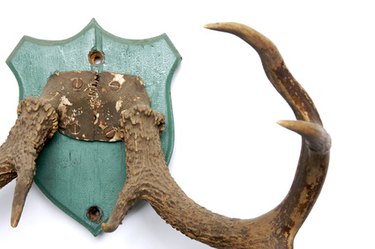Deer antlers are extremely hard and should always be worked with using extreme caution. Inadequate preparation can lead to accidents and possible injury. However, working with deer antlers can also be extremely gratifying. Whether you are using antlers to make crafts or to simply hang on your wall, the knowledge that you were able to work with this age-old material is deeply self-satisfying.

Video of the Day
Things You'll Need
Pencil
Deer Antlers
Power Buffer Or Fingernail Buffer
Sandpaper
Measuring Tape
Semi-Gloss Polyurethane Spray
Handsaw
Vise
Step 1
Determine what antler you want to use for your project and how it needs to be altered. Measure the antler and mark it with a pencil at the location of the cut. Measuring ensures that the cut is in the correct location and that there are no errors. The correct location of the cut will be dictated by the instructions for your project (i.e. an antler for a handle needs to be two inches long).
Video of the Day
Step 2
Measuring methods for the antler will vary and depend upon the project you have chosen. If your project focuses on the tips of the antlers, such as a coat hanger, then measure from the very tip of the antler toward the base. If your project showcases the bases of the antlers, like cabinet pulls, measure from the base toward the tip.
Step 3
Secure the antler in a vise attached to your work surface. It is important to put the antler in a vise, rather than holding it with your hand, to avoid injury.
Step 4
Cut the antler exactly on the marked line using a hand saw. Hold the hand saw firmly, and guide it down through the antler as you are cutting. Make as many cuts as needed for your project.
Step 5
Sand the deer antler with fine grit sandpaper to remove rough edges and smooth the ends of the antler.
Step 6
Buff the deer antlers with a power buffer. If you don't own one, you can use a fingernail buffer to make the antlers shine.
Step 7
Spray the antlers with a coat of semi-gloss polyurethane to maintain the shine. Allow the polyurethane to dry for at least 72 hours before handling. However, applying the polyurethane is not necessary if you prefer a more natural look.
Warning
You should wear a simple respirator when working with antlers to avoid breathing excess dust from the cutting and sanding process.